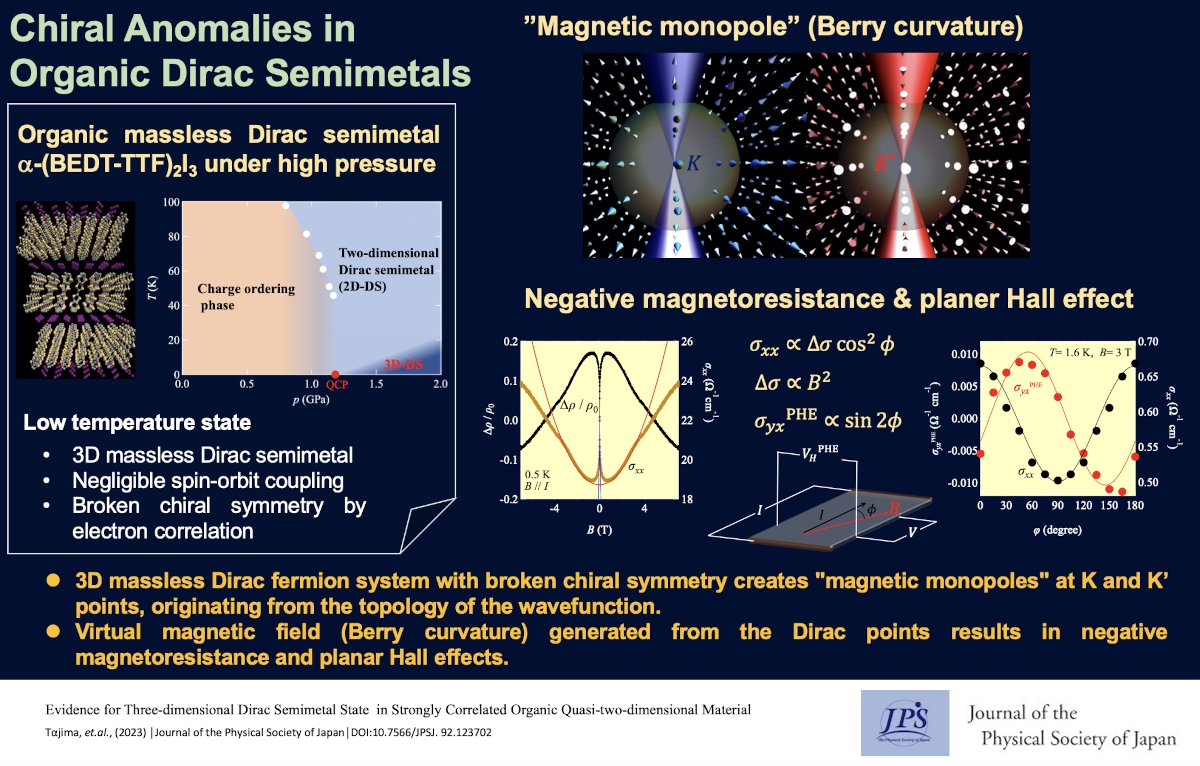Chiral Anomalies in Organic Dirac Semimetals
© The Physical Society of Japan
This article is on
Evidence for Three-dimensional Dirac Semimetal State in Strongly Correlated Organic Quasi-two-Dimensional Material
(JPSJ Editors' Choice)
J. Phys. Soc. Jpn. 92, 123702 (2023).
A three-dimensional massless Dirac fermion system exhibiting broken chiral symmetry was successfully realized in organic conductor α-(BEDT-TTF)2I3 under high pressures. Our study detected the chiral anomaly-induced negative magnetoresistance and planar Hall effects and opened new avenues for further advancements in the field.

Conservation laws that hold in classical theory can be violated in quantum mechanics, a phenomenon known as the “chiral anomaly.” This intriguing violation of the conservation laws has been the focal point of research in particle physics and astrophysics for many years. However, recently, physical phenomena stemming from chiral anomalies have been observed in topological materials, revealing that chiral anomalies are a universal phenomenon that also manifest in solid-state systems.
Chiral anomaly effects in solids result in pronounced responses, including transport phenomena without scattering, such as negative magnetoresistance, planar Hall effects, and anomalous Hall effects. Consequently, topological materials that exhibit chiral anomalies have garnered significant interest for potential device applications.
Broken chiral symmetry is crucial for the occurrence of chiral anomalies, and the dimensionality of electron motion is another key factor. According to quantum field theory, chiral anomalies are present in three-dimensional (3D) systems but absent in two-dimensional (2D) systems. Typically, Dirac semimetals are categorized as either 2D or 3D, with no materials bridging these dimensions yet. To explore the physics behind chiral anomaly effects, candidate materials capable of transitioning between 2D and 3D dimensionalities have been searched.
We propose that organic conductor α-(BEDT-TTF)2I3 under high pressures emerges as a prime candidate material. This is the first bulk (multilayered) massless Dirac fermion system identified. Although various physical phenomena within this system have traditionally been interpreted through a 2D framework, the evidence of coherent interlayer tunneling at low temperatures reveals its intrinsic 3D nature. Theoretical insights indicate that this system functions as a 3D Dirac semimetal with chiral symmetry broken by electron correlation.
In the 3D Dirac semimetal with broken chiral symmetry, a “magnetic monopole”—stemming from the topology of the wave function—is formed at the two Dirac points, K and K', analogous to the N and S poles. The observation of negative magnetoresistance and planar Hall effects, driven by a virtual magnetic field (known as the Berry curvature) emanating from the Dirac points, confirms the realization of a 3D Dirac semimetal with chiral anomalies in α-(BEDT-TTF)2I3 under high pressures at low temperatures. This system provides a pivotal platform for probing chiral anomalies.
(Written by N. Tajima on behalf of all authors)
Evidence for Three-dimensional Dirac Semimetal State in Strongly Correlated Organic Quasi-two-Dimensional Material
(JPSJ Editors' Choice)
J. Phys. Soc. Jpn. 92, 123702 (2023).
Share this topic
Fields
Related Articles
-
Antiferromagnetism Induces Dissipationless Transverse Conductivity
Electronic transport in condensed matter
Magnetic properties in condensed matter
Electronic structure and electrical properties of surfaces and nanostructures
2024-7-24
An investigation using high-quality NbMnP crystals demonstrates that the anomalous Hall conductivity arising from antiferromagnetism is dissipationless, as expected from the intrinsic mechanism.
-
Exploring Electronic States in BEDT-TTF Organic Superconductors
Superconductivity
Electronic transport in condensed matter
Magnetic properties in condensed matter
2024-4-24
This review, published in the Journal of the Physical Society of Japan, provides a comprehensive summary of the electronic states observed in BEDT-TTF type organic superconductors, including metal-insulator transitions, Mottness transitions, non-Fermi liquids, quantum spin liquids, and Bose-Einstein condensation.
-
Conversion of Chiral Phonons into Magnons in Magnets
Electronic transport in condensed matter
2024-4-1
A new phenomenon involving the conversion of chiral phonons into magnons is theoretically predicted. The effective magnetic field induced by chiral phonons causes a change in the spin magnetization of magnets.
-
Variety of Mechanically Induced Spin Currents in Rashba Systems
Electronic transport in condensed matter
Magnetic properties in condensed matter
Structure and mechanical and thermal properties in condensed matter
2024-3-22
Various types of spin currents, including unconventional types, are generated in Rashba spin-orbit coupled systems by dynamic lattice distortions associated with, for example, surface acoustic waves.
-
What Determines the Sign of Spin Current? ~ Theoretical Study of Spin Seebeck Effect in Antiferromagnetic Insulators
Electronic transport in condensed matter
2024-3-18
We developed a microscopic theory for the spin Seebeck effect in antiferromagnets, that explains the sign reversal of the spin current at the spin-flop transition point and describes the sorts of dominant carriers.
